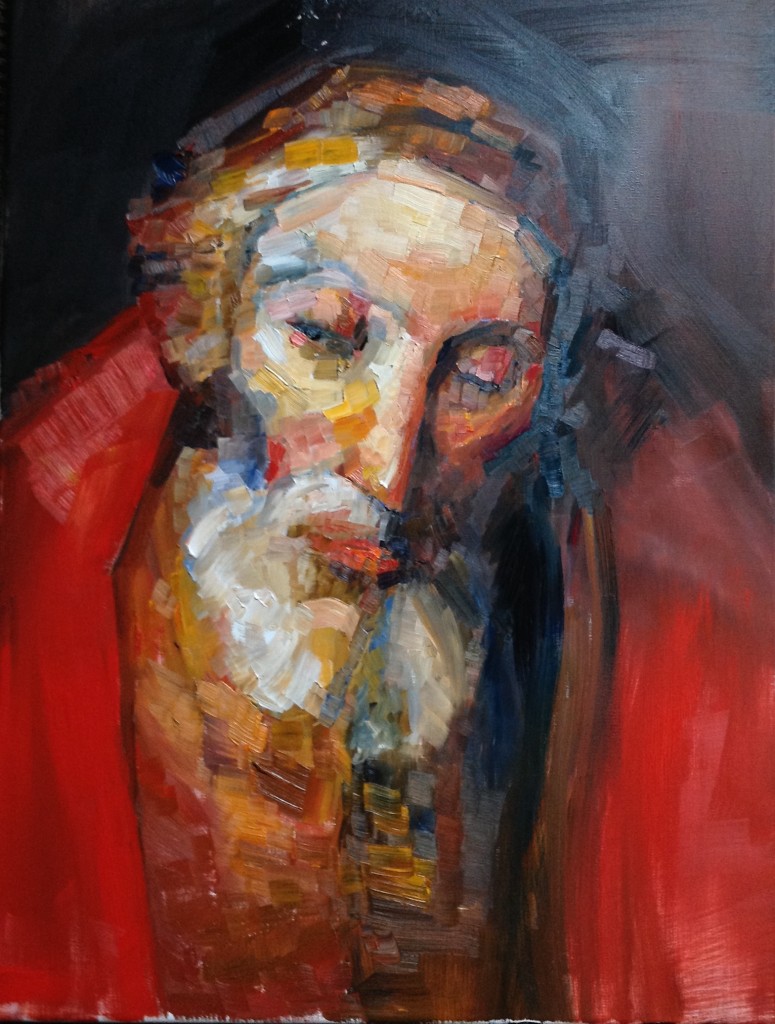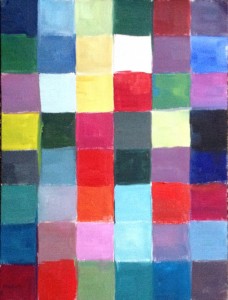 Quite a day in the studio — in communion, as it were, with two towering geniuses, Rembrandt and Shakespeare (they are both so unmistakably god-like that I am tempted to write communion with a capital “C”…)
Quite a day in the studio — in communion, as it were, with two towering geniuses, Rembrandt and Shakespeare (they are both so unmistakably god-like that I am tempted to write communion with a capital “C”…)
Now I think about that, I should have somehow add Bach to this company — to cover all realms of art while I am at it. But even as it was, it was filled with awe and joy: that’s the joy of the path I have chosen in art, the path towards complete surrender, letting go of the idea of “self-expression”.
So, two themes of this studio day: approaching sonnet eight two, and my Rembrandt study (the very initial stages of it).
 The sonnet work started with a colour chart, just as a way to feel my way into it, and then, later on, continued with letting it play in my mind during the afternoon walk in the park. While making this colour chart, I understood that the major challenge of this sonnet is in its falsehood, in the plainest sense of saying something one doesn’t believe to be true. That’s what happens when you try to write a letter to someone at whom you are really mad, but whom you don’t want to anger; you want to let them know how wrong they were, but not directly. You are trying to be polite and politic, to put yourself in their shoes, to see and accept their point of view. Even to flatter them — if only to get your point across, which makes you even angrier; but all the while you don’t believe a single word you are saying. It is this falsehood, I felt, that finally breaks out from the all too elegant flesh of the sonnet with the four repetition of “true” in lines eleven and twelve (“The lady doth protest too much” all over again).
The sonnet work started with a colour chart, just as a way to feel my way into it, and then, later on, continued with letting it play in my mind during the afternoon walk in the park. While making this colour chart, I understood that the major challenge of this sonnet is in its falsehood, in the plainest sense of saying something one doesn’t believe to be true. That’s what happens when you try to write a letter to someone at whom you are really mad, but whom you don’t want to anger; you want to let them know how wrong they were, but not directly. You are trying to be polite and politic, to put yourself in their shoes, to see and accept their point of view. Even to flatter them — if only to get your point across, which makes you even angrier; but all the while you don’t believe a single word you are saying. It is this falsehood, I felt, that finally breaks out from the all too elegant flesh of the sonnet with the four repetition of “true” in lines eleven and twelve (“The lady doth protest too much” all over again).
But how on earth can I find a way to express this falsehood, a falsehood that sees itself for what it is, in a painting? How do you make a painting false, but simultaneously true at a higher level — at the level of faithfully recreating the experience of pretending? This particular experience of pretending because you are hurt, but don’t want to be hurt even more?
In Shakespeare, this falsehood shows up as an increased politeness, elegance, regularity. My colour chart revolves around clashing of greens and reds, and muted magentas/greys — that seems to be my preliminary colour solution, but there is no vision of the painting yet.
I tried to remember all the times when I wrote this kind of letters (the first association was the experience of responding to a negative and stupid “peer review”), but that didn’t seem to be emotionally charged enough, not anymore.
During the walk, though, it seems I was able to dig a bit deeper. My earlier thoughts connected themselves with this contrast between two levels of communication, two “selves”: the more expansive understanding of “self” suggested by Sonnet 81, and the narrowed, contracted “self” of Sonnet 82. The “smaller” self, which arises when the larger one collapses in response to being hurt, angered, jealous, afeared.
A poet has a better channel of communication with the more expansive “self” than most of us, but they are also a “person”, a narrow self. So this clash, this contraction of self, this scratching when the whole space collapses through a narrow “key hole” of the smaller, personal “self” — this clash is more tangible, more palpably felt. This is the experience I ought to paint here — and I left this train of thoughts at this point, hoping that from that the painting would emerge from them later on.
Most of the time in the studio was spent on this study of Rembrandt: the old man’s head from “The return of the prodigal son”. I expected much more struggle, more technical problems, but the overall experience was effortlessly joyful, exhilarating even. When you just paint what you see — the colours, the brushstrokes, without thinking about any recognisable objects (like eyes, or forehead, or lips), and then the old man’s tired face emerges out of this brushwork as though by a miracle, just by trusting Rembrandt leading your hand.
I deviated from his brushwork, and his way of paint application, quite substantially though. And I was aware, while painting, that my emotional connection to this painting, or at least to this study, is sustained by the understanding, the guess, the recognition, that that’s how my father might have looked like had he been alive now. My attention slipped a bit by the end of the session — and that immediately showed up in the painting. This slip of attention was experienced as an attempt to paint the face (as opposed to “just” Rembrandt’s colour areas), which resulted in it looking much less like a face.
I will (obviously) return to both these themes in the days to come…